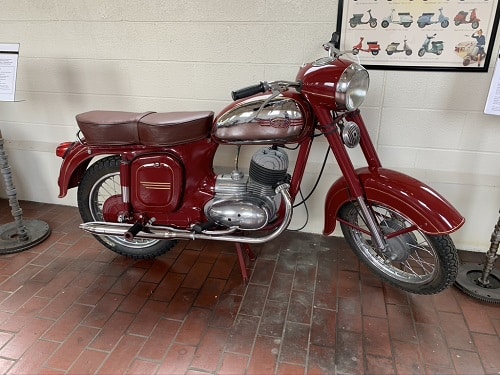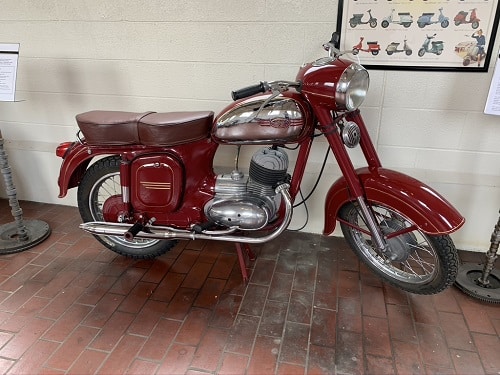
Jawa 175cc- 1959

After the decline of the armaments industry, in 1929 Czech engineer and inventor František Janeček began producing motorcycles. He purchased the German motorcycle company Wanderer from Winklhofer & Jaenicke and named the new company Jawa Motokov, created by merging the names JAneček and WAnderer.
In the 1930s, Janeček began experimenting with smaller, 2-stroke, 250cc and 350cc engines. He hired renowned British racer and engineer G.W. Patchett, a former racer, to take on the project. Patchett served as the chief designer for Jawa until the outbreak of World War II. Patchett’s first step towards a motorcycle that served the masses was using his connections with the Villiers Co. to use their 175cc 2-stroke engine. In 1931 the Jawa 175 model was unveiled, and by 1933 had become the most popular motorcycle in Czechoslovakia. Because it was lightweight, powerful, and had great handling, the Jawa 175 made an excellent choice. It was also inexpensive and was marketed under the catch phrase, “A popular motorcycle for the people’s price.”
In 1933, František Janeček also started producing small passenger cars with two-cylinder two-stroke engines and front-wheel drive. A licensing agreement with DKW enabled him to produce the Jawa 700, based on the DKW F2. Engines were produced in Prague, the bodies assembled and the cars completed in Tynec nad Sazavou, not far from Prague. In 1949, Jawa was forcibly merged under communist nationalization with CZ, (Česká zbrojovka)—a Czech armaments manufacturer turned successful motorcycle producer. Jawa built the larger-capacity motorcycles – 250cc and 350cc while CZ produced the smaller 125cc, 150cc and 175cc motorcycles. Jawa built street bikes while CZ were mostly off-road bikes.
The 1959 Jawa CZ 175cc on display here features an alluring figure of undulating double seat, rounded gas tank and bulbous headlamp. A bold red outline of frame, body panels, and enclosed chain-guard offer a feeling of solidity. Speed can be imagined in the headstock of its chrome-lined lamp with integrated speedometer and in the flare of its substantial fenders. The enclosed side panels under the seat contain tool compartments and swoop down to seamlessly cover the rear of the engine.
Jawa and CZ separated in 1960. Introduced in India in the 1950s, Jawa motorcycles developed a strong following; they are still being produced under the Ideal Jawa and Yendi names. Today, Jawa motorcycles continue to be manufactured in several parts of Europe.
Specifications:
Manufacturer: JAWA Motokov
Country of Origin: Czechoslovakia
Engine: Air-cooled 175cc 2-stroke single-cylinder; 6 hp @ 3750rpm
Transmission: 4-speed
Top Speed: 55 mph
Years of Production: 1948-?
Number Produced: Unknown
Original Cost: 2,050 new francs in 1960 (about $415)
